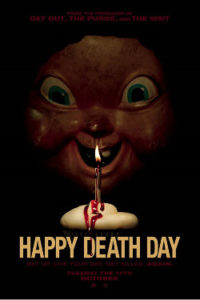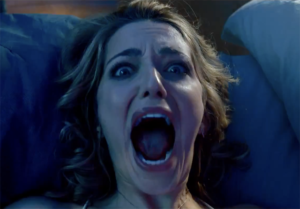“There is no way that this winter is *ever* going to end as long as this groundhog keeps seeing his shadow. I don’t see any other way out. He’s got to be stopped. And I have to stop him.” – Phil, Groundhog’s Day
“There’s an opposite to déjà vu. They call it jamais vu. It’s when you meet the same people or visit places, again and again, but each time is the first. Everybody is always a stranger. Nothing is ever familiar.” – Chuck Palahniuk, Choke
 Creating a slasher film version of Groundhog’s Day was the most brilliant marketing ploy of 2017. Who doesn’t love Groundhog’s Day? If someone says they don’t, they are either lying or a they are a much deeper threat to cinematic orthodoxy than Pelagius was to Christianity in the 4th century. The concept of Happy Death Day is so simple that it might actually be low key brilliant. It will just be a matter of time before we have the Groundhog’s Day cinematic universe where no genre will ever be safe from the existential plight that happens when a person is forced to re-live the same day for eternity.
Creating a slasher film version of Groundhog’s Day was the most brilliant marketing ploy of 2017. Who doesn’t love Groundhog’s Day? If someone says they don’t, they are either lying or a they are a much deeper threat to cinematic orthodoxy than Pelagius was to Christianity in the 4th century. The concept of Happy Death Day is so simple that it might actually be low key brilliant. It will just be a matter of time before we have the Groundhog’s Day cinematic universe where no genre will ever be safe from the existential plight that happens when a person is forced to re-live the same day for eternity.
The beauty of bringing this conceit into horror and, more specifically, the slasher subgenre is that it becomes a subtle commentary on the liturgy of the slasher film contained in one easily digestible film. Within its runtime, Tree Gelbman (played by Jessica Rothe) lives the same day and dies by the hand of a killer wearing the mask of the school mascot over and over again. We see the varying plotlines of a whole baby-faced killer slasher franchise in an hour and thirty minutes. It is left up to Tree to figure out who her killer is in order to stop the slasher loop.
In the process, however, we see Tree having a similar makeover as Phil did in Groundhog’s Day. They begin to recognize that they are not quite the hero or the center of the universe they once thought they were. Something happens within their psyche as they have seemingly unlimited ability to evaluate even the microscopic details of that loop and see how the divine tapestry is woven and how their actions continually fray the weave. In some sense, this is wish fulfillment. It’s what we do in our heads after making a decision. How could we have handled that differently? Better? Could we have been more gracious or more forthright? Our minds are replaying the same week, day, hour, minute, moment over and over again. Constantly trying to unmask the killer or destroy that rodent.
 The genius of both of these films is that what gets them out of the loop is actually not the element that makes them great, but the transformation that happens in the process of them trying to break the cycle. They begin to see their low anthropology—that we are not anywhere near as good as we think we are—and they start to reassess themselves in light of others. Tree begins to recognize her vapidness, how her need for attention destroys other peoples’ lives, her apathy towards how others are treated, etc., and she learns that all the sorrow, guilt and suffering causes her to hate herself also. It takes an extended bout of déjà vu to make her realize her own “jamais vu”—that her life was such that all the people she saw day to day were actually strangers to her. They were bit players in her Shakespearean tragedy. In living the same day over again, she was given the opportunity to actually see them as they were. Her father, who, too, was grieving his wife’s death. Carter, who was probably the only guy who didn’t take advantage of her drunkenness. And her sorority sisters, who she comes to realize are just as vapid and insecure as she was.
The genius of both of these films is that what gets them out of the loop is actually not the element that makes them great, but the transformation that happens in the process of them trying to break the cycle. They begin to see their low anthropology—that we are not anywhere near as good as we think we are—and they start to reassess themselves in light of others. Tree begins to recognize her vapidness, how her need for attention destroys other peoples’ lives, her apathy towards how others are treated, etc., and she learns that all the sorrow, guilt and suffering causes her to hate herself also. It takes an extended bout of déjà vu to make her realize her own “jamais vu”—that her life was such that all the people she saw day to day were actually strangers to her. They were bit players in her Shakespearean tragedy. In living the same day over again, she was given the opportunity to actually see them as they were. Her father, who, too, was grieving his wife’s death. Carter, who was probably the only guy who didn’t take advantage of her drunkenness. And her sorority sisters, who she comes to realize are just as vapid and insecure as she was.
And the killer. Someone she recognizes, but is actually a stranger to her. She sees that person for the first time as well. It takes leaning into the suffering and confusion of this liturgy of death to self to be broken from the cycle. For Tree, the final realization is that she is the cause for the killer. How she got into this cycle of living the same day over again, like with Groundhog Day, is just a Deus Ex Machina with no explanation. But it is liturgy. It is repetition towards transformation. This is what repetition does. It makes of ever so cognizant of who we really are, how we respond in situations, where our blind spots are, and when our teeth are bared.
 The filmmakers did not set out to make a film as rich and as unique as Groundhog’s Day, but they saw the connection between that film and slashers and knew that repetition is key to successful horror franchises. Yet they still kept the heart of the original by drawing the focus down to what actually happens to the person caught in the loop. They change. They transform. They recognize that they are not the main actor in their very own play, but that they are one of many actors in the grandest production ever made. One with a baby-faced serial killer. And, you know, that just makes it even better.
The filmmakers did not set out to make a film as rich and as unique as Groundhog’s Day, but they saw the connection between that film and slashers and knew that repetition is key to successful horror franchises. Yet they still kept the heart of the original by drawing the focus down to what actually happens to the person caught in the loop. They change. They transform. They recognize that they are not the main actor in their very own play, but that they are one of many actors in the grandest production ever made. One with a baby-faced serial killer. And, you know, that just makes it even better.


